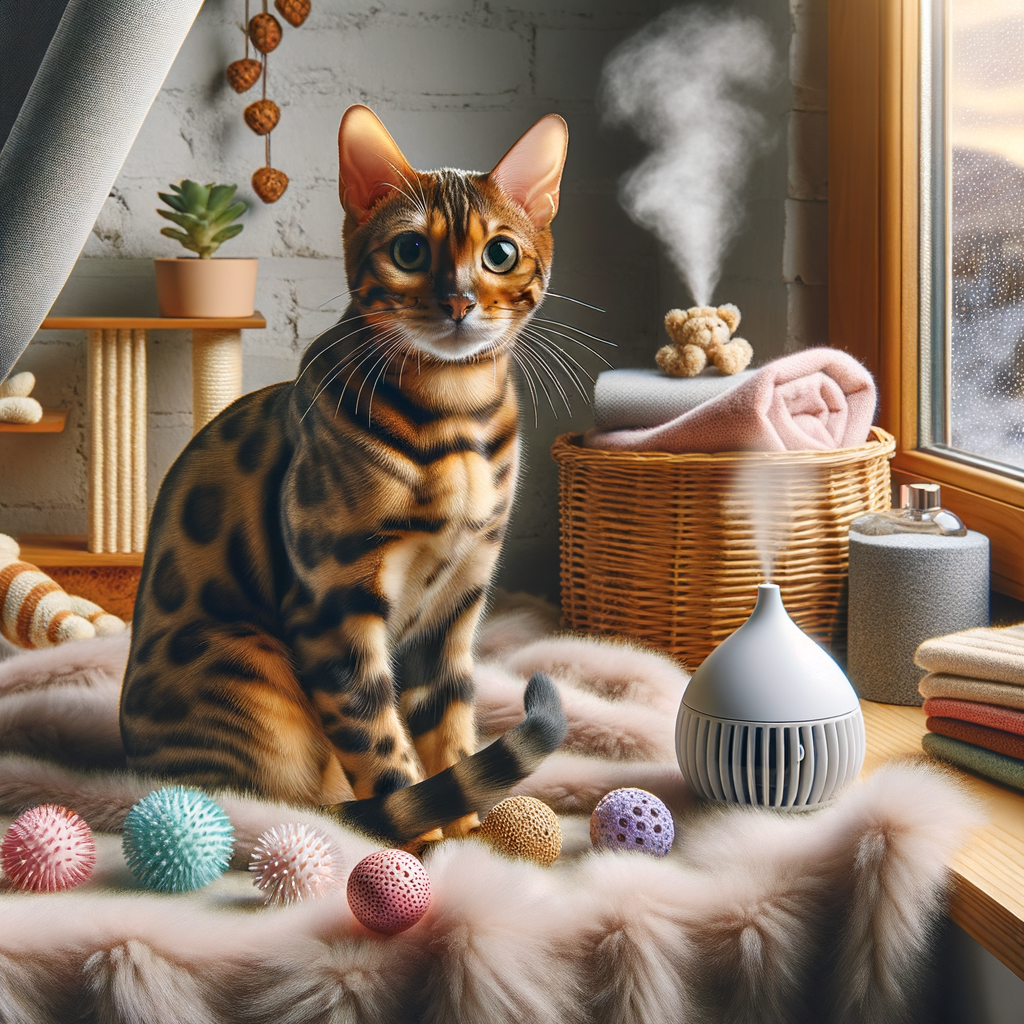
Introduction to Bengal Cat Separation Anxiety
Bengal cats are known for their playful and energetic nature. However, like many pets, they can experience separation anxiety. Understanding this condition is crucial for any Bengal cat owner.
- Understanding Bengal cat behavior issues: Bengal cats are highly social animals. They thrive on interaction and can become distressed when left alone for long periods. This can lead to behavior issues such as excessive meowing, destructive behavior, or even refusal to eat.
- Recognizing signs of Bengal cat separation anxiety: It’s important to know the signs of separation anxiety in Bengal cats. These may include:
- Excessive vocalization
- Destructive chewing or scratching
- Urinating outside the litter box
- Over-grooming or self-harm
- Loss of appetite
By recognizing these signs early, you can take steps to help your Bengal cat feel more secure and comfortable when alone.
Managing Bengal Cat Anxiety: What You Need to Know
Importance of Bengal Cat Mental Health
- Impact of anxiety on Bengal cat’s overall health: Anxiety can affect your Bengal cat’s physical health. Stress may lead to issues like loss of appetite, weight loss, and a weakened immune system. It’s crucial to address anxiety early to keep your cat healthy and happy.
- Long-term effects of untreated Bengal cat anxiety: If anxiety is left untreated, it can lead to more severe problems. Chronic stress can cause behavioral issues, such as aggression or excessive grooming. Over time, it may also result in serious health conditions like heart disease or diabetes.
Common Triggers of Bengal Cat Anxiety
- Changes in environment
Bengal cats are sensitive to changes in their surroundings. Moving to a new home, rearranging furniture, or even adding new pets can make them anxious. It’s important to introduce changes slowly to help them adjust.
- Lack of social interaction
Bengal cats are social animals. They need regular interaction with their owners and other pets. Without enough social time, they can feel lonely and stressed. Make sure to spend quality time playing and bonding with your Bengal cat daily.
- Health issues
Health problems can also trigger anxiety in Bengal cats. If your cat is feeling unwell or in pain, it may become anxious. Regular vet check-ups can help catch and treat health issues early, keeping your Bengal cat happy and healthy.
Reducing Bengal Cat Anxiety at Home
- Creating a safe space for your Bengal cat:
It’s important to provide a secure and quiet area where your Bengal cat can retreat when feeling anxious. This space should be away from loud noises and busy areas of your home. Include comfortable bedding, favorite toys, and a scratching post. This helps your cat feel safe and reduces stress.
- Using calming techniques for Bengal cats:
There are several methods to calm an anxious Bengal cat. One effective technique is using pheromone diffusers, which release calming scents similar to those produced by cats. Another method is gentle petting and talking softly to your cat. Additionally, interactive play sessions can help burn off excess energy and reduce anxiety.
Professional Help for Bengal Cat Anxiety
Sometimes, Bengal cat anxiety can be too much to handle on your own. If your cat shows signs like excessive meowing, destructive behavior, or loss of appetite, it might be time to seek professional help. According to Wikipedia, separation anxiety in cats can lead to serious health issues if not addressed.
Here are some signs that indicate you should seek professional help:
-
- Constant meowing or crying when left alone
- Destructive behaviors like scratching furniture
- Changes in eating or sleeping habits
- Excessive grooming or hair loss
Types of Professionals Who Can Help
There are various professionals who can assist with Bengal cat anxiety. Knowing who to contact can make a big difference in your cat’s well-being.
| Professional | How They Help |
|---|---|
| Veterinarian | Can rule out medical issues and may prescribe medication. |
| Animal Behaviorist | Specializes in understanding and altering animal behavior. |
| Cat Trainer | Provides training to reduce anxiety through behavior modification. |
Each professional offers unique skills to help your Bengal cat. Consult your veterinarian first to determine the best course of action.
Bengal Cat Alone Time Tips: Ensuring Comfort
- How to prepare your Bengal cat for alone time
Preparing your Bengal cat for alone time is important. Start by creating a safe and cozy space for them. This could be a quiet room with their favorite toys, a comfy bed, and a scratching post. Make sure they have access to fresh water and a clean litter box.
Gradually get them used to being alone by leaving them for short periods at first. Slowly increase the time you are away. This helps them understand that you will come back. You can also leave a piece of your clothing with your scent to comfort them.
- Activities to keep your Bengal cat engaged
Bengal cats are very active and curious. They need lots of mental and physical stimulation. Here are some activities to keep them engaged:
-
- Treat-dispensing toys: These toys make your cat work for their treats, keeping them busy and entertained.
- Interactive feeders: These feeders turn mealtime into a fun game, stimulating their hunting instincts.
- Cat trees and climbing structures: Bengals love to climb. Provide them with vertical spaces to explore.
- Window perches: Set up a perch by a window so your cat can watch birds and other outdoor activities.
- Automated laser toys: These toys can keep your cat chasing and pouncing, even when you are not home.
Key Takeaways: Easing Your Bengal Cat’s Separation Anxiety
It’s important to know the signs of separation anxiety in Bengal cats. These can include excessive meowing, destructive behavior, and changes in eating habits. Understanding these signs helps you address the issue early.
- Implementing practical Bengal cat anxiety solutions:
There are several ways to help ease your Bengal cat’s anxiety. Providing toys, creating a safe space, and maintaining a routine can make a big difference. These solutions help your cat feel more secure and less stressed.
- Using Bengal cat alone time tips for comfort:
When you have to leave your Bengal cat alone, make sure they have plenty of activities to keep them occupied. Interactive toys, puzzle feeders, and cozy resting spots can provide comfort and reduce anxiety.
- Seeking professional help when necessary:
If your Bengal cat’s anxiety is severe, don’t hesitate to seek help from a veterinarian or a pet behaviorist. They can offer specialized advice and treatment options to ensure your cat’s well-being.






